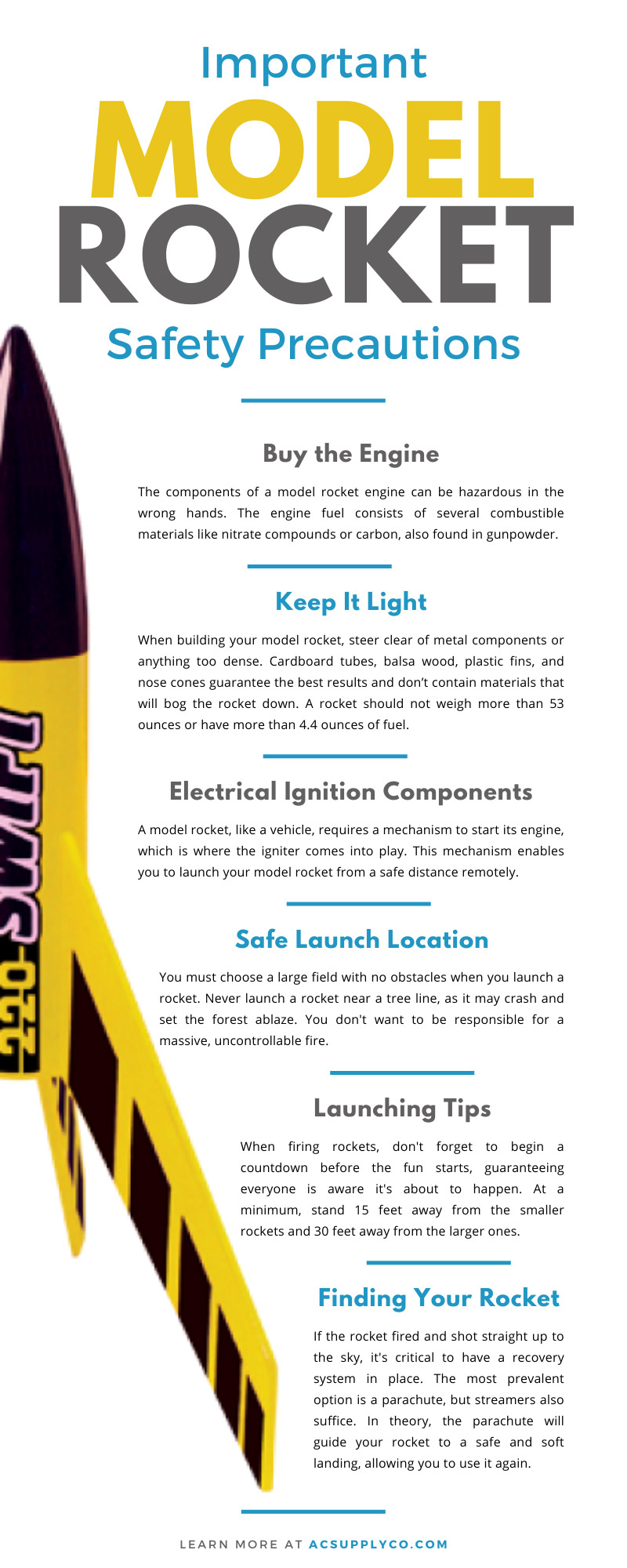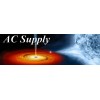Science experiments are always a joyous experience but can also be extremely dangerous if you don’t exercise caution. When firing a model rocket, there are several things you should consider. These seven important model rocket safety precautions are essential for those working on model rockets.
Buy the Engine
The components of a model rocket engine can be hazardous in the wrong hands. The engine fuel consists of several combustible materials like nitrate compounds or carbon, also found in gunpowder.
Although building the model rocket engine would be an immersive learning experience for all, it is best advised to use pre-assembled models. You can find a moderately priced engine that's safe to use to prevent injury.
When you think you have found the one, inspect the engine before inserting it into the rocket to ensure it is in excellent shape and devoid of flaws or cracks. You should never use a rocket engine twice, so assuming it's new and without defects, you can confidently insert the engine into your model rocket.
Keep It Light
When building your model rocket, steer clear of metal components or anything too dense. Cardboard tubes, balsa wood, plastic fins, and nose cones guarantee the best results and don’t contain materials that will bog the rocket down. A rocket should not weigh more than 53 ounces or have more than 4.4 ounces of fuel. Otherwise, it will not work to its fullest capabilities and can become dangerous.
After you double-check the engine to verify that it's safe, examine the rest of the rocket to verify there are no loose or missing pieces. However, you mustn’t overtighten some of its components, or the engine may not work as expected. Thus, before you give the proverbially green light, confirm that the engine is secure and ready to fire on all cylinders.
Electrical Ignition Components
A model rocket, like a vehicle, requires a mechanism to start its engine, which is where the igniter comes into play. This mechanism enables you to launch your model rocket from a safe distance remotely.
A model rocket igniter is compact and easily fits within the rocket engine. But it must have enough potency to ensure a proper takeoff. Additionally, the ignitor should not damage the engine once it fires.
The ignition supplies the heat source required to initiate the rocket engine. These delicate but powerful wires employ an electrical current to the model rocket's electro-explosive system, propelling it skyward.
Small model rockets often feature a remote control to ignite the rocket. Within the installed rocket engine, a link between the igniter and the engine is fastened by a plug. When it ignites, the plug will release, starting the engine.
The most prominent model rocket manufacturer is Estes, and their rockets contain a distinctive igniter with two large wires and a small wire at the top, known as the bridge wire.
Because the bridge wire is highly brittle, avoid placing the igniter in your rocket engine until it is almost close to launching. The bridge wire provides heat to ignite the miniature rocket engine.
Halt and Misfires
While it's nice to assume that everything will go off without a hitch, misfires tend to happen, even if you triple-check all the rocket's components. To prevent a rocky launch, there are precautions you can take.
- Confirm that the ignition wires protrude from the tip of the pyrogen. Learn from Ghostbusters and never cross the streams; these wires must never touch each other.
- Flip the rocket upside down with the nozzle pointing up. Many rockets aren't reliable if the nozzle is pointing down.
- Carefully place the igniter in the nozzle. If the tip isn't touching the igniter, you may not have enough juice to launch it.
- Use the parts designated for that particular rocket. You might have other parts that fit lying around, but you're bound to have a malfunction if you mix and match.
- Be careful where you hook up the igniter clips. Many fall into the trap of putting the ignition wire too close to the pivot point of the clip. It needs to be close, but don't force things.
Following these tips will minimize the chances of a misfire that can ruin the entire experience.
Safe Launch Location
You must choose a large field with no obstacles when you launch a rocket. Never launch a rocket near a tree line, as it may crash and set the forest ablaze. You don't want to be responsible for a massive, uncontrollable fire.
You should also resist launching a rocket near a highway or well-traveled roads. If a driver sees a model rocket flying nearby, it could be enough of a distraction that leads to a significant accident.
Additionally, please don't launch near your or anyone's home, especially considering that most neighborhoods have electrical lines everywhere.
Lastly, save launch day for another time if the wind is gusting and erratic. There is no telling what strong gusts will do to your rocket.
Launching Tips
When firing rockets, don't forget to begin a countdown before the fun starts, guaranteeing everyone is aware it's about to happen. At a minimum, stand 15 feet away from the smaller rockets and 30 feet away from the larger ones.
A mass launch of rockets will require you and everyone else to stand further away from the launch site.
Use a tower or launch rod to give your rocket the best chance to be as vertical as possible. Also, use a blast deflector to prevent the exhaust from touching the ground.
Finding Your Rocket
If the rocket fired and shot straight up to the sky, it's critical to have a recovery system in place. The most prevalent option is a parachute, but streamers also suffice. In theory, the parachute will guide your rocket to a safe and soft landing, allowing you to use it again.
However, if something goes awry and your rocket is in a dangerous location like a crowded street, in a tree, or tangled in power lines, you will have to construct another one because it's far too risky to retrieve it.
Adhering to these seven important model rocket safety precautions is necessary before planning any rocket launch. As prefaced above, don't build model rocket engines yourself. Instead, let AC Supply be your engine provider. We offer free shipping in the lower 48 states for orders exceeding $100!



